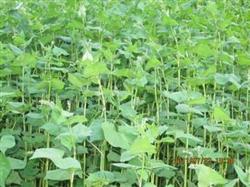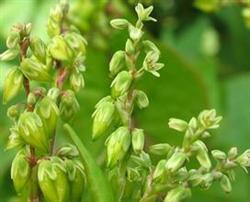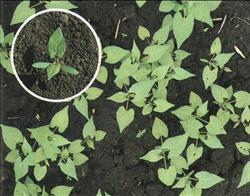Key points of cultivation techniques of buckwheat

Buckwheat has short growth period, strong adaptability, moderate yield and high nutritional and health value. It is a good crop for filling and disaster relief. There is a habit of growing buckwheat in all parts of my county. In order to obtain a stable harvest of buckwheat after the disaster, we must grasp the following key technical links: 1. Select improved varieties. It is advisable to select buckwheat varieties with a growth period of 70-80 days and strong resistance. Avoid using old seeds, it is best to use new seeds harvested last year. 2. Seed treatment. 2-3 days before sowing, seed selection is carried out by soaking seeds in warm water, namely soaking seeds in warm water at 40 DEG C for 10-15 minutes, removing floating grains, and taking out and drying the full grains which sink below. In places where pests and diseases are serious, seed dressing can be carried out. In order to shorten the time from sowing to emergence, seed can be stored in warm soup for 1-2 days, and seeds can be sown immediately when they begin to germinate. 3. Fine soil preparation. Buckwheat seedlings have poor topsoil ability, weak root system development, and high requirements for soil preparation. We should do our best to cultivate and soil preparation. The flat land needs to be ditched and the width of the ridge is 5-6 feet; the gentle slope should also be opened according to the terrain to facilitate drainage. 4. Seeding at the right time. Buckwheat likes warm and cool environment, afraid of frost, sowing too early or too late, will seriously affect the yield. The suitable sowing period in our county is around the middle and late July. 5. Reasonable close planting. Buckwheat can be broadcast, drill and hole sowing. The sowing amount per mu is 4-5 kg, ensuring 80,000 - 100,000 basic seedlings; the row spacing is 0.6-0.7 feet, the sowing amount per mu is 3 - 4 kg, ensuring 60,000 - 80,000 basic seedlings per mu; the hole sowing adopts the specification of 0.7-0.8 feet ×1.0 feet, the sowing amount per mu is 1.0- 12,000 litters, 8-10 seeds per litter, and the sowing amount per mu is 2-2.5 kg. Sowing depth 3-4 cm is appropriate. Buckwheat seeds must germinate under dark conditions. After sowing, it is required to cover a layer of fine soil to ensure that the seedlings are uniform. 6. Increase fertilizer application. Buckwheat is barren tolerant, but suitable application of phosphorus and potassium fertilizer can significantly increase yield. Fertilizer can be applied as seed fertilizer, generally in the soil preparation when applying 45% compound fertilizer 8-10 kg or 25% compound fertilizer 15-20 kg per mu, and add appropriate amount of high-quality organic fertilizer. When applying fertilizer, pay attention to separating fertilizer from seeds to prevent seedling burning. 7. Strengthen cultivation management. First, it is necessary to eliminate waterlogging and prevent drought, pay attention to clearing ditches and draining water to prevent waterlogging and death of seedlings; in case of drought during seedling emergence period, timely furrow irrigation to moisten soil moisture in areas where conditions permit, or sprinkle diluted excrement water in the morning and evening before emergence. Second, it is necessary to cultivate and weed in time. When it rains after sowing, it is necessary to break the soil hardening layer in time, and cultivate and weed twice before the seedling height is 6-8 cm and flowering. Third, it is necessary to supplement fat and prevent aging. From flowering to fruiting stage, 0.5 kg urea, 200 g potassium dihydrogen phosphate and 60 kg water are sprayed 1-2 times per mu. Fourth, auxiliary pollination. Buckwheat natural pollination seed set rate is low, flowering period should be assisted by artificial pollination. Bees can be pollinated or pulled back and forth gently on the upper layer of the plant with ropes or thin bamboo poles at 8-10 am for 2-3 times (interval 3-5 days). Fifthly, to prevent and control pests and mice, pay attention to the use of low-toxicity pesticides. 8. Timely harvest. When 70% buckwheat seeds are dark brown, they should be harvested early and late, tied up or tied up, placed indoors vertically, so that buckwheat is fully ripened, and then threshed and dried for storage.
- Prev

Cultivation techniques of bitter buckwheat in autumn
(1) selection of varieties. Tartary buckwheat varieties with many branches, concentrated seeds, early seed setting, high seed setting rate, strong cold resistance and high yield were mainly selected. (2) fine land preparation. Soil preparation requires fine, tillage depth of about 20 cm, removal of pre-cropping residues and weeds, conducive to sowing and emergence, deep ploughing fine rake, so that the soil flat.
- Next

Buckwheat needs less fertilizer, but fertilizer is expensive.
Buckwheat has short growth period, rapid growth, slender stem and underdeveloped root system, so it is a kind of crop that needs less fertilizer. Generally speaking, for every 100 kg buckwheat grain produced, about 3.3 kg of nitrogen, 1.5 kg of phosphorus and 4.3 kg of potassium need to be absorbed from the soil. The specific amount of fertilizer application will be due to soil texture, cultivation conditions, climate characteristics,.
Related
- The first cup of black tea in spring, the flavor and history of tea gardens in Kenya, Africa
- The computer can not only choose potatoes, but also grow tea rice. AI will grow winter oolong tea champion.
- It is not only the inflated tea bitten by insects, but also engraved with the four seasons tea in Beipu.
- The Oriental Beauty Tea Festival in Zhuxian County takes the stage at the weekend to experience the plus-size feast of oil tea.
- & quot; Oriental Beauty Tea & Exploration of Emei in Hsinchu, the hometown of quot;
- The new variety of strawberry "Tainong 1" dessert is the first choice with mellow aroma. Crimson gorgeous
- History of Tea in Taiwan: from Wild Inner Mountain to Export Tea Garden
- Two types of Taiwan Oriental Beauty Black Tea won the British three-Star Award for Childhood Tea Xiang Zhang Jiaqi changed from pilot to champion tea maker.
- Banana species and varieties: the planting history of Taiwan Xianren banana and dwarf banana is long, is banana disease resistant?
- Coffee planting Technology: Qianjie Coffee from Seedling to harvesting

